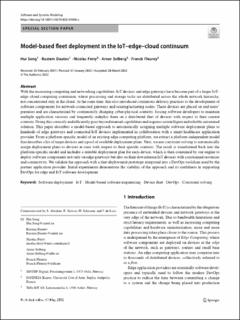| dc.contributor.author | Song, Hui | |
| dc.contributor.author | Dautov, Rustem | |
| dc.contributor.author | Ferry, Nicolas | |
| dc.contributor.author | Solberg, Arnor | |
| dc.contributor.author | Fleurey, Franck | |
| dc.date.accessioned | 2022-09-21T13:57:16Z | |
| dc.date.available | 2022-09-21T13:57:16Z | |
| dc.date.created | 2022-06-27T18:42:10Z | |
| dc.date.issued | 2022 | |
| dc.identifier.citation | Software and Systems Modeling. 2022. | en_US |
| dc.identifier.issn | 1619-1366 | |
| dc.identifier.uri | https://hdl.handle.net/11250/3020269 | |
| dc.description.abstract | With the increasing computing and networking capabilities, IoT devices and edge gateways have become part of a larger IoT–edge–cloud computing continuum, where processing and storage tasks are distributed across the whole network hierarchy, not concentrated only in the cloud. At the same time, this also introduced continuous delivery practices to the development of software components for network-connected gateways and sensing/actuating nodes. These devices are placed on end users’ premises and are characterized by continuously changing cyber-physical contexts, forcing software developers to maintain multiple application versions and frequently redeploy them on a distributed fleet of devices with respect to their current contexts. Doing this correctly and efficiently goes beyond manual capabilities and requires an intelligent and reliable automated solution. This paper describes a model-based approach to automatically assigning multiple software deployment plans to hundreds of edge gateways and connected IoT devices implemented in collaboration with a smart healthcare application provider. From a platform-specific model of an existing edge computing platform, we extract a platform-independent model that describes a list of target devices and a pool of available deployment plans. Next, we use constraint solving to automatically assign deployment plans to devices at once with respect to their specific contexts. The result is transformed back into the platform-specific model and includes a suitable deployment plan for each device, which is then consumed by our engine to deploy software components not only on edge gateways but also on their downstream IoT devices with constrained resources and connectivity. We validate the approach with a fleet deployment prototype integrated into a DevOps toolchain used by the partner application provider. Initial experiments demonstrate the viability of the approach and its usefulness in supporting DevOps for edge and IoT software development. | en_US |
| dc.language.iso | eng | en_US |
| dc.publisher | Springer | en_US |
| dc.rights | Navngivelse 4.0 Internasjonal | * |
| dc.rights.uri | http://creativecommons.org/licenses/by/4.0/deed.no | * |
| dc.subject | Software deployment | en_US |
| dc.subject | IoT | en_US |
| dc.subject | Model-based software engineering | en_US |
| dc.subject | Device fleet | en_US |
| dc.subject | DevOps | en_US |
| dc.subject | Constraint solving | en_US |
| dc.title | Model-based fleet deployment in the IoT–edge–cloud continuum | en_US |
| dc.title.alternative | Model-based fleet deployment in the IoT–edge–cloud continuum | en_US |
| dc.type | Peer reviewed | en_US |
| dc.type | Journal article | en_US |
| dc.description.version | publishedVersion | en_US |
| dc.rights.holder | © The Author(s) 2022 | en_US |
| dc.source.journal | Software and Systems Modeling (SoSyM) | en_US |
| dc.identifier.doi | https://doi.org/10.1007/s10270-022-01006-z | |
| dc.identifier.cristin | 2035550 | |
| dc.relation.project | Norges forskningsråd: 309700 | en_US |
| dc.relation.project | EC/H2020/101020416 | en_US |
| dc.relation.project | EC/H2020/780351 | en_US |
| cristin.ispublished | true | |
| cristin.fulltext | original | |
| cristin.qualitycode | 2 | |

